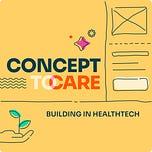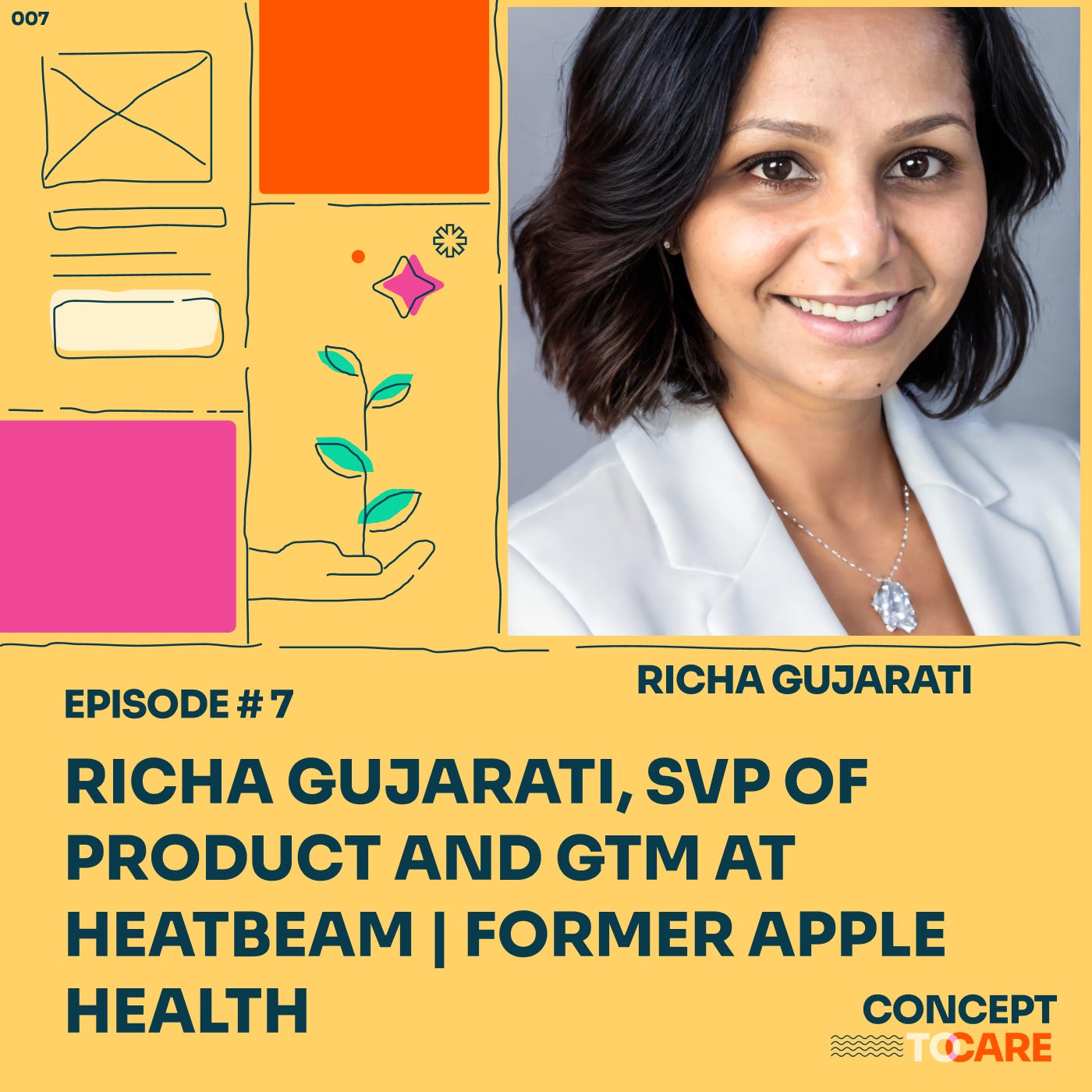Today on Concept to Care, we're joined by Richa Gujarati, the Senior Vice President of Product and GTM Strategy at HeartBeam. HeartBeam is a cardiac technology company that has developed the first and only credit card-sized 3D-vector electrocardiogram platform for home use.
We'll explore the genesis of Richa’s career in product and go-to-market strategy, tracing her journey through renowned organizations such as Johns Hopkins, St. Jude Medical, iRhythm, and Apple Health. You’ll discover the critical role of evidence generation in successfully bringing a healthcare product to market and learn strategies to achieve it.
Richa will delve into the intersection of product development and go-to-market strategy, offering insights on recognizing when these elements are in sync and how to realign your organization if they are not. She will share her expertise on competing with industry giants and maintaining a competitive edge, as well as tips on selling to health systems.
Additionally, Richa will provide her unique perspectives on the evolving role of product management in the health tech industry and advice on becoming a successful product manager in this field.
Some takeaways:
Evidence generation is essential for a health tech solution to achieve market adoption, clinical acceptance, and patient trust. Without solid evidence, the solution is unlikely to succeed. To generate this evidence, it's crucial to get the technology into the hands of clinicians and patients. But how can you convince purchasing decision-makers to support this process? Product and go-to-market (GTM) teams need to be innovative in placing the solution with clinicians and patients. One effective strategy is to identify a clinical champion who will advocate for the solution and manage the administrative and cost burdens associated with its adoption.
Traditional Clinical R&D organizations share some common themes with modern healthcare product management. However, they often lack the ability to assess how their activities drive long-term business outcomes, a crucial aspect of product management. Product can bridge the gap by effectively aligning clinical efforts with business objectives and demonstrating the impact of their work on business growth. Empowered product organizations have the agency to connect the dots between clinical, technology, sales, and marketing to drive key results.
Taking a healthcare product from concept to commercial viability is challenging. Here are two strategies recommended by Richa:
Start small and focus on a niche user problem
Starting small is crucial because behavior change in healthcare is challenging. Large-scale problems often don't prompt immediate behavior changes, but addressing smaller, acute issues can foster willingness to adopt new solutions.
Begin with a clear product strategy that targets a very specific problem with significant pain points. Ignore the total addressable market (TAM) initially and focus on a niche use case where the pain is acute and pressing. This problem should encourage customers and users to change their behavior or their thinking about the existing solution.
Solve the small problem and do it very well. By solving a critical problem effectively, you can gain initial traction with the target customer or end user. This approach not only demonstrates the value of your solution but also earns you the right to expand into other markets and address larger issues over time.
Utilize journey mapping to determine where to expand and focus across the value chain
Journey mapping is an invaluable tool in healthcare, though often underutilized. It helps you understand how different personas interact with a particular solution, highlighting pain points and critical touch points throughout the user journey.
Once you've gained traction by addressing a small problem in the user journey, you can begin tackling larger issues. Journey mapping will guide you in pinpointing where to focus your efforts next, helping you identify opportunities to expand into larger-scale problems.
iRhythm exemplified a classic David and Goliath story. By effectively combining product innovation with a strategic go-to-market approach, iRhythm successfully drove adoption, outperformed established competitors, and achieved significant expansion. Here is how they did it.
iRhythm inherently knew that they were not going to displace incumbent cardiac monitoring solutions outright because they were part of a hospitals capital expenditure (CapEx) and so they would have to find a creative way to get their cardiac monitoring solution into the hands of a clinician for evidence generation / adoption
iRhythm analyzed the existing cardiac monitoring user journey for care delivery teams and patients with the intention to find an acute problem to focus on and solve really well. They learned this:
Cardiac monitors were extremely uncomfortable for patients to use and patients didn’t want to wear them for 24 hours which was a blocker for getting sufficient cardiac data
Physicians lacked trust in the data being generated by the cardiac monitors given what they knew about the device’s poor patient experience and would have to order repeat tests to correct the device adherence.
Lab techs suffered from administrative burden from having to analyze bad data and having their lab queues backed up with repeat testing results
iRhythm identified the patient problem to be the source of all the problems faced across the cardiac monitoring user journey and deployed extreme focus on solving that niche pain point to stand a chance of converting one clinical champion to take on their solution without having to fully swap out the existing one
iRhythm was successful because they picked a niche problem to solve for a niche patient population. Trough evidence generation and adoption from clinical champions they were able to “land and expand” from their niche solution to a broader set of solutions
It’s important to have Product and GTM teams working in lock step to remove any friction filled touch points with the solution that could potentially prevent the product from getting into the hands of the intended end-user. Here are ways to mitigate that risk:
Own the deployment and integration. Product teams should determine how the solution is deployed to any given customer and how it is integrated into a customers workflow. This will ensure best results.
Create roles who are accountable. Consider creating a role called “Implementation Specialist” within your Product and GTM teams. The primary purpose of this role is to mitigate any risks associated with deploying the solution to customers and to ensure proper onboarding for optimal adoption.
What advice do you have for product managers who want to change how their product and GTM teams collaborate. Richa provided the following advice:
Focus on what you can change. Consider what actions you can take within your role to drive change. For product managers at any level, it's essential to focus on how the product they're developing contributes to long-term business outcomes and work backwards from there. Start by gathering evidence to support your hypothesis that product and GTM teams should collaborate more closely, and then share this insight with everyone.
Adopt an experimentation approach. Start with a hypothesis, design a small test, and collect data. Share your findings on how the experiment could drive outcomes, secure buy-in for further investment, and prioritize the broader rollout of changes.
Some advice on how to sell technology solutions into health systems:
Build relationships. For early-stage startups, focus on building strong relationships. Find champions who will advocate for your product. Turn them into product advocates by involving them in the design and development process, making them invested in the solution. Invite them to be part of the journey, which increases their commitment and investment in your product.
Enable your champions. Provide your champions with sales enablement materials to help them market and advocate for your product within their own organization.
Utilize advisors. Identify potential advisors within target customer groups and leverage them to create a feedback loop, ensuring whatever solution you’re selling is effectively solving their customer problem.
Lessons learned at Apple Health: Creating additional revenue streams with Apple Watch beyond direct-to-consumer (DTC) sales through partnerships with payers and pharmaceutical companies.
Focusing on data for preventive care is crucial. Payers aim to reduce overall costs of managing their member population by offering plan benefits that entice subscribers and promote health, lowering care costs. Apple Watch features can help payers achieve these goals by motivating consumers to adopt long-term healthy behaviors, thus promoting preventive care and reducing downstream costs.
Support and enhance clinical trial administration, data collection, and adherence with the help of Apple Watch. Pharma clinical trials benefit from tools like the Apple Watch, which seamlessly integrate into the daily lives and workflows of research patients or participants. This aids in patient retention and ensures accurate, consistent data collection.
A fresh perspective on the modern-day product manager in health tech. Many experts define product management with detailed function descriptions and strict do's and don'ts. Richa offers a unique viewpoint that stands apart from the common narrative.
Product management is about doing whatever it takes to drive business outcomes for your offering. That’s the essence of the role. It’s not confined to a specific function, job type, or workflow. It’s about doing whatever is necessary to achieve the business outcome. If you’re not linking your actions to business outcomes, you’re falling short in your role
Attributes of a successful “hardware PM” in health tech
Product Strategy is Crucial: Mastering product strategy and making informed trade-offs are essential skills.
Long Feedback Cycles: Mistakes are costly due to extended feedback loops, so accuracy is vital.
Understanding MVP: Have a strong grasp of what constitutes a true Minimum Viable Product.
Implications of Trade-offs: Be adept at considering the implications of trade-offs in decision-making.
Limited Iteration Opportunities: Unlike pure software, hardware doesn’t allow for frequent iterations.
User Testing and Research: Conduct thorough user testing and research to prevent costly mistakes.
Long-term Thinking: Plan strategically with a 3-5 year outlook.
Buy vs. Build Decisions: Hardware PMs must strategically decide between buying and building, knowing the high costs of development.
Independence from Apps: Ensure hardware performs its basic functions independently of the app to succeed as a hardware PM.
Coaching PMs in health tech on engaging with customers
Identify where users gather the most, such as Reddit groups and Facebook groups, to learn about their pain points and challenges as patients.
Create and distribute surveys in these online communities to gather insights.
Attend conferences to connect with users and industry professionals.
Organize and invite users to participate in focus groups.
Visit hospitals to observe procedures where your product is used, gaining firsthand insights.
Involve engineering teams in these observations to enhance their understanding and gather valuable feedback.
—
Where to find Richa Gujarati:
email: rgujarati@heartbeam.com
—
Where to find Angela and Omar:
Angela Suthrave
Omar Mousa
—
Referenced:
HeartBeam Company Website:: https://www.heartbeam.com/
HeartBeam press release appointing Richa for SVP of Product and GTM: https://ir.heartbeam.com/news-events/press-releases/detail/58/heartbeam-appoints-richa-gujarati-and-pooja-chatterjee-to
Apple Health Website:: https://www.apple.com/ios/health/
iRhythm Technologies Company Website: https://www.irhythmtech.com/
Press announcement that St. Jude Medical is getting acquired by Abbot: https://www.abbott.com/corpnewsroom/strategy-and-strength/st-jude-medical-is-now-abbott.html
Johns Hopkins Bioengineering Innovation and Design, Master of Science in Engineering: https://e-catalogue.jhu.edu/engineering/full-time-residential-programs/degree-programs/biomedical-engineering/innovation-design-master-science-engineering/
Growth of the Evidence Base for Digital Health is Crucial for the Adoption: https://www.linkedin.com/pulse/growth-evidence-base-digital-health-crucial-adoption-joseph-kvedar/
Understanding the Role of Clinical Champions and Their Impact on Clinician Behavior Change: The Need for Causal Pathway Mechanisms: https://www.ncbi.nlm.nih.gov/pmc/articles/PMC10012807/
Richa’s favorite everyday tooling:
monday.com for task management and some roadmapping functionality: https://monday.com/
Miro for flow diagramming and user journey mapping: https://miro.com/
dragonboat.io: for organizing product portfolios: https://dragonboat.io/
Richa’s favorite books:
Blue Ocean Strategy by Chan Kim and Renée Mauborgne: https://www.blueoceanstrategy.com/what-is-blue-ocean-strategy/
The Lean Startup by Eric Ries: https://theleanstartup.com/
If you’re a hardware PM looking to network — direct message Richa on LinkedIn or Twitter
Twitter: https://x.com/richaguj20
—
Check out our website: https://www.concepttocare.com
Follow us and Subscribe wherever you get your podcast:
















Share this post